Pharm Exec's Top 50 Companies 2019
Pharmaceutical Executive
Our 19th annual listing reveals some interesting maneuvering of ranks, as companies focus on diversification, big-brand expansions, and positioning a new wave of products to compete in an advancing but complex future treatment market.
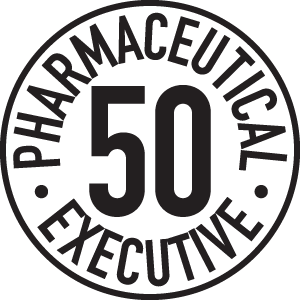
Pharm Exec’s annual listing of the top global biopharma players reveals some interesting maneuvering of ranks, as companies focus on diversification, big-brand expansions, and positioning a new wave of products to compete in an advancing but complex future treatment market
The top spot in our annual scorecard updating the 50-best drug sales producers in global biopharma-now in its 19th iteration-remained unchanged for the fourth straight year (Pfizer, please step forward). However, the jockeying of positions underneath, interestingly, experienced its fair share of movement compared to recent years. The maneuvering may be indicative of factors such as business diversification; still well-entrenched patent protections; further expanded indications of popular therapies; more targeted portfolio and pipeline pursuits; and the challenges for once-novel drugs-even curative “firsts”-in maintaining market share.
Or perhaps the modest shuffling is a small signal to the bigger changes to come for the biopharma and healthcare enterprises-changes in operational strategy and advances in medical science and technology still too far on the horizon to manifest themselves significantly in big pharma and biotech’s commercial output.
In data again provided in partnership with life sciences market intelligence firm Evaluate Ltd, Pfizer ranked first in 2018 prescription drug revenue, totaling $45.3 billion (see the explainer of how the listings were calculated at bottom of table below). Notably, for Pfizer, sales of breast cancer drug Ibrance, which in April won FDA approval for men with HR+, HER2- metastatic breast cancer, spiked 31.7% last year from 2017 full-year figures. Pfizer’s oncology portfolio, along with Eliquis and the company’s biosimilars, are reportedly expected to drive near-term earnings growth for the pharma giant. Last year, Eliquis overtook warfarin to become the leader in the US oral anticoagulants market.
Roche and Novartis swapped the second and third slots in the latest rankings, with Roche inching past Novartis with an increase of 6.8% in Rx sales. Roche also spent more than any company on R&D, investing $9.8 billion. Herceptin remains Roche’s top-selling medicine, but its patent has expired, and according to a report in Reuters, the drug’s sales dropped 16% in Europe last year, and potential US competition looms this year from biosimilars from Celltrion and Teva, Pfizer, and Mylan. If the deal goes through, Roche will add sales and pipeline assets via its February acquisition of Spark Therapeutics for $4.8 billion (as of press time, the offer was in its second extension period). In late 2017, Spark won approval for Luxturna, the first-ever targeted gene therapy, which treats inherited retinal blindness. Spark also focuses on gene therapies for hemophilia, lysosomal storage diseases, and neurodegenerative disorders.
Click to enlarge
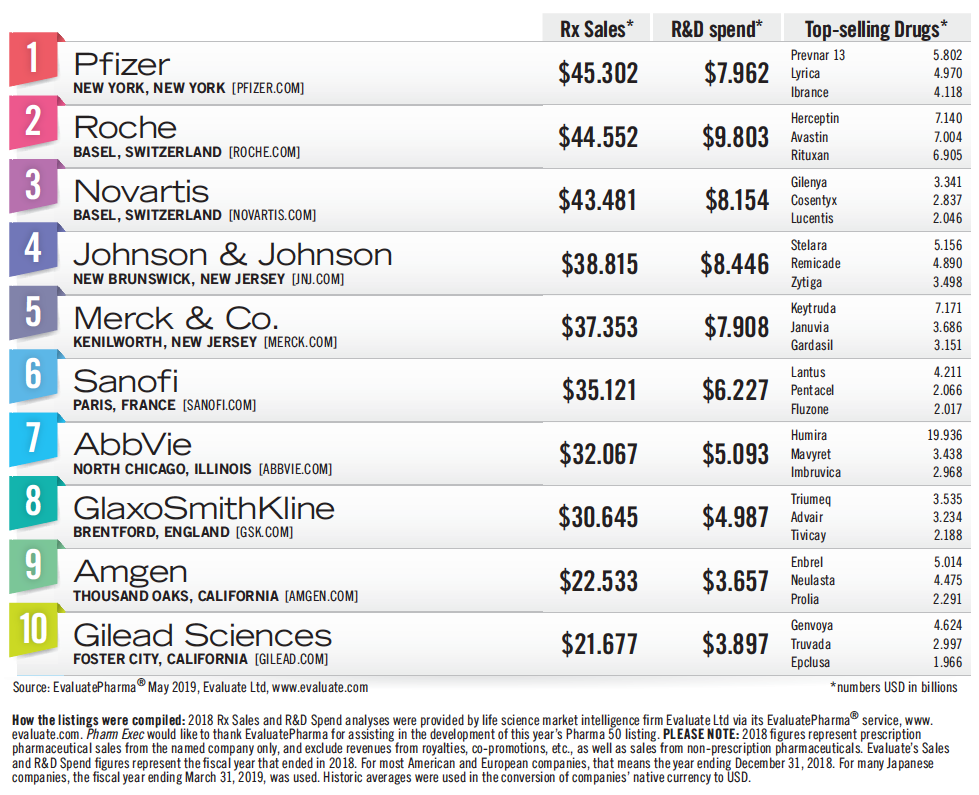
Novartis, which posted a 3.8% rise in drug revenue on our list, has received a lot of recent attention around its own gene therapy product, Zolgensma, approved by FDA late last month to treat children under two years of age with spinal muscular atrophy, a potentially deadly disease. Novartis priced the one-time infusion at $2.1 million, a sticker price that has turned heads, and is illustrative of the new waters gene therapies in general pose for healthcare systems and payers, and government and regulators, in figuring out how to cover and fund these products (see our Washington correspondent’s report here). After first deeming Zolgensma not cost-effective at the $2.1 million price tag, the Institute for Clinical and Economic Review (ICER) reversed course last month based on review of new data and value-based payment plans. According to published reports, Novartis says it has ample manufacturing capacity to meet Zolgensma launch demands. Production hurdles contributed to a slower rollout for Novartis’s cell therapy Kymriah, the world’s first CAR-T drug, which gained its first approval in August 2017. Kymriah targets acute lymphoblastic leukemia (ALL).
With less fanfare than the CAR-T wave received, but perhaps with greater blockbuster potential in the near-term, Novartis won regulatory clearance last month for Piqray, the first drug designed specifically for HR+/HER2- breast cancer patients with a PIK3CA mutation. It’s also the first novel drug approved under the FDA’s Real-Time Oncology Review pilot program. Mainstay Gilenya generated $3.3 billion in sales in 2018, but reports state that dermatology drug Cosentyx eclipsed Gilenya in the first quarter of this year to become Novartis’s top-selling product.
The company’s philosophy has been not to rely on one or two treatments to drive growth, but to anchor drug assets across six therapeutic areas (in recent reports, Novartis claims to have 25 blockbuster candidates in the clinic). Predictions published by Yahoo and FiercePharma say Novartis will be the world’s top drug seller by 2024. Could the Swiss-based giant leapfrog Pfizer and Roche in our Pharma 50 rankings in the next few years to secure the top perch for the first time since 2015?
Other notable shifts in top 10 positioning include:
n Johnson & Johnson’s move up one spot to No. 4, behind drug sales growth of 12.8% compared to the previous year.
n Merck & Co., though ceding way to J&J, posted a 5.6% gain on the steam of its expanding flagship Keytruda, the cancer immunotherapy. Sales of the drug rose 88% in 2018, to $7.2 billion. (Keytruda is projected to reach annual sales of $10 billion in its fifth year). It won FDA approval in April as a first-line treatment for patients with stage III non-small cell lung cancer (NSCLC) who are not candidates for surgical resection or definitive chemoradiation. Keytruda was also greenlighted in combination with Pfizer’s Inlyta for previously untreated kidney cancer.
n AbbVie flipped spots with GlaxoSmithKline-jumping to seventh on the list. The company posted a 15.6% gain in Rx revenue behind $19.9 billion in sales of Humira. Though Humira’s EU patent expired last year, AbbVie has reached settlements to fend off US biosimilar competition until January 2023. In preparation, however, the company is attempting to bolster sales for its newer drugs Skyrizi and upadacitinib; for example, it’s offering discounts on Humira to secure favorable formulary coverage for Skyrizi, a monoclonal antibody approved in the US and Europe in April for psoriasis (it boasts advantages in less-frequent dosing and had better skin clearance rates during clinical testing than similar drugs on the market).
n Gilead, which despite strong sales from its HIV drugs, fell one spot to No. 10. The biotech’s overall prescription drug revenue dropped 15.5%, due in large part to continued declines in its hepatitis C virus (HCV) drug franchise, where the once-pioneering medicines Harvoni and Sovaldi-which cure patients of HCV after one course of treatment-have lost market share to rival drug launches in recent years.
Next page: Rankings 11-50
Rest-of-field observations
Just outside of the top 10, Bristol-Myers Squibb claims the 11th spot in our rankings, with Keytruda PD-1 inhibitor rival, Opdivo, pulling in $6.7 billion in sales, a 36% increase. The momentum may be squelched some by BMS’s voluntary withdrawal earlier this year of its application for Opdivo in combination with Yervoy as first-line treatment for advanced non–NSCLC patients with tumor mutational burden, and Opdivo’s failure in a Phase III brain cancer study, announced last month. Eliquis, which BMS manufacturers in partnership with Pfizer, continued to grow at a more than 30% annual clip.
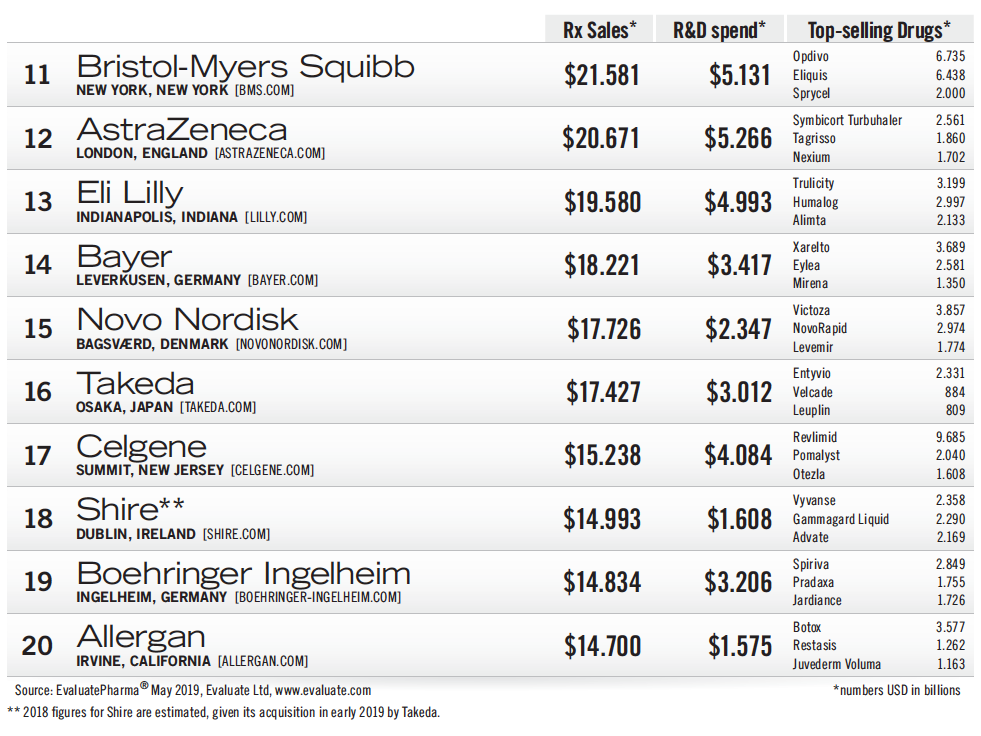
BMS is poised to climb up the rankings ladder in the coming years after its $74 billion merger with Celgene, which after months of wrangling, was finally approved by BMS shareholders in April. The deal is expected to close in the third quarter of this year, adding several new drug candidates from Celgene’s pipeline, including potential multiple sclerosis blockbuster ozanimod. BMS will also gain the rights to Revlimid, Celgene’s longtime big seller for cancer, and its CAR-T portfolio, which the biotech acquired last year through its $9 billion takeover of Juno Therapeutics. Revlimid continues to expand into new patient populations, winning FDA approval in late May, paired with Roche’s Rituxan, as a chemotherapy-free combination drug for patients with previously treated follicular or marginal zone lymphomas.
21-30; click to enlarge
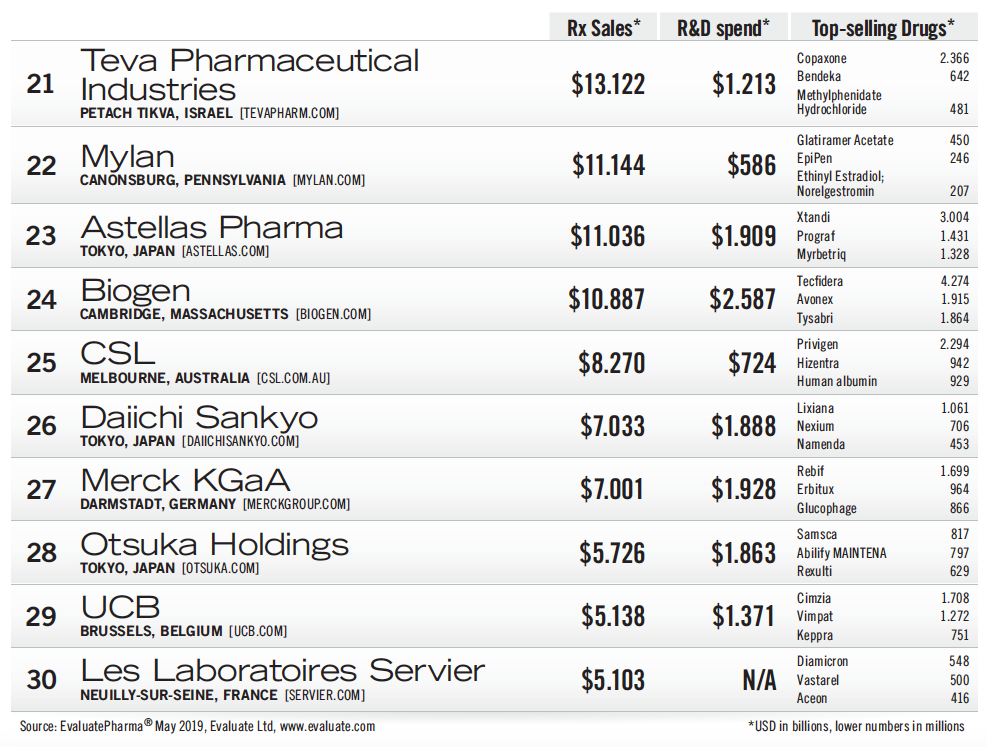
In Rx sales, Celgene leapt from the 21st spot to 17th in this year’s rankings. According to Evaluate’s data, BMS and Celgene increased their R&D spend in 2018 by 6.4% and 35.4%, respectively. Celgene’s spike was the highest among companies investing at least $1 billion in R&D. Another notable R&D output was Regeneron’s, who despite ranking 38th in drug sales, spent the 21st most on R&D, investing $2.2 billion.
New entrants this year in the Pharma 50 include Hong Kong-based Sino Biopharmaceutical at 42nd; Boston’s Vertex Pharmaceuticials at 43rd; and French biopharma Ipsen and China-headquartered Jiangsu Hengrui Medicine at 46th and 47th, respectively.
31-40
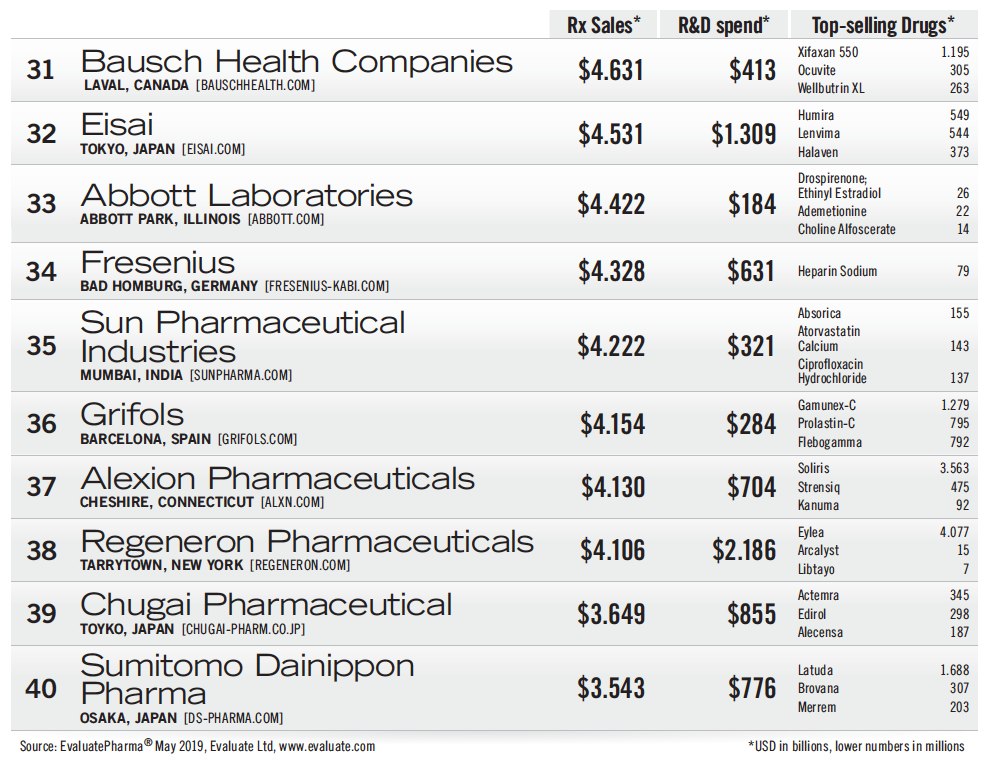
Dealing and diversifying
The BMS-Celgene and Roche-Spark deals, along with Eli Lilly’s $8 billion acquisition of Loxo Oncology, may signal the start of a wave of M&A activity in the industry that will last into 2020, analysts say, as companies look to increase diversification into new areas and put more R&D resources into therapeutic niches with strong pricing power, such as rare diseases. According to a report by Evaluate, rare and orphan drugs will make up one-fifth of worldwide prescription sales in 2024, amounting to $242 billion in spend.
41-50
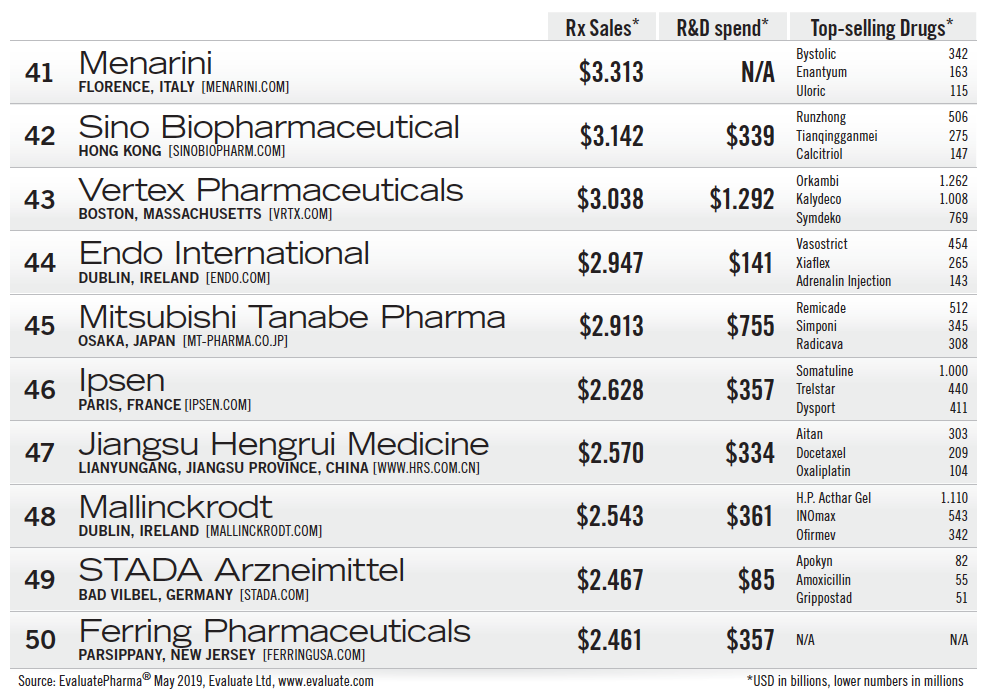
Takeda’s acquisition of rare diseases specialist Shire, first announced in March 2018, was officially closed in early January for $62.2 billion, making it the largest biotech employer in Massachusetts and thrusting the company into the top 10 of pharma revenue producers. In other mega deals, GSK last year bought out Novartis’s stake in their consumer health joint venture for $13 billion, and merged its consumer business with Pfizer, as part of GSK’s plan to split into two separate businesses; and Sanofi completed its acquisition of Bioverative, a US biotech focused on hemophilia and other rare blood disorders, for $11.6 billion.
On the generics front, Mylan, ranked 22nd in our list with $11.1 billion in 2018 drugs sales, agreed in May to buy Aspen Pharmacare’s portfolio of prescription and over-the-counter products in Australia and New Zealand for $130 million; and Mallinckrodt, ranked 48th, announced plans to spin off its generic drug business as a separate unit and rename the remaining specialty branded drugs business to Sonorant Therapeutics Plc. Mylan and Teva are among 20 generics makers named in a lawsuit issued last month by 44 US states for alleged price-fixing.
A likely influencer in this year’s Pharma 50 is the continued boom of the specialty pharma market. Recent numbers issued by the Peterson-Kaiser Health System Tracker found that among commonly used specialty drugs, branded drug prices have increased by 57% since 2014. Meanwhile, spending for prescription drugs overall, perhaps surprisingly, has been relatively flat, at least according to government and private industry sources. MarketWatch reported in March that the cost of Rx over the preceding year had dropped by 1.2%-the biggest 12-month decline since 1972.
World gains, mission
Another driver impacting our numbers are the growth rates of multinational drugmakers in emerging markets. According to published reports, in the first quarter of this year, emerging markets growth averaged 13.3% among a selection of big pharmas, with 29% in China-compared to 8.2% growth in the US. With the pharma industry facing rising demands to improve global health and preserve their public health missions, a new study by the Access to Medicine Foundation found that drugmakers “are taking seriously the problems people face in low- and middle-income countries when accessing healthcare,” but the progress has been sporadic with often only a few diseases in a small number of countries being targeted. The study, which analyzed 10 years of data, does note that the R&D pipeline has more than doubled since 2014 for a set of 47 high-burden and priority diseases, including HIV/AIDS, malaria, and tuberculosis, and that pharma companies are using pricing, licensing, and donations more frequently than before as tactics to improve access in low- and middle-income countries.
It’s these dynamics in global healthcare that bring us to this year’s special Pharma 50 accompanying feature by guest author Lauren Seufert, the founder of emOcean Coaching & Consulting In setting the stage for a piece on biopharma leadership strategies amid change, Seufert points to the organizational disruption taking place on a global scale. Examples she cites are trade wars with the East and the continuing debate around global vs. national focus in many regions. Combined with disruptions from technology advancement and digitalization, new business models governing all parts of the value chain, economic fluctuations around

the globe, and evolving social and political landscapes, Seufert emphasizes the importance of pharma executives in preparing their companies to thrive in this future VUCA world (volatility, uncertainty, complexity, and ambiguity).
Meanwhile, pharma C-suite leaders continue to deal with the larger industry’s reputation and trust challenges. That’s particularly true in the US, where public sentiment regarding the industry actually improved some this year, according to Edelman’s annual trust barometer. Its research reported an increase of six points in the US, bringing pharma’s total up to 44 (a score of 60 or more is considered “trusted” under the Edelman ratings). The pharma industry’s overall global trust rating increased four points to 67, ranking in the lower half of the 15 industries studied.
R&D reshaped
A shifting climate and operational environment for clinical research could begin to start influencing the Pharma 50 sooner than later. In 2018, the FDA approved 59 new molecular entities, the highest annual number in history (enlarge chart below), with 27% of those precision medicines to treat cancer and its symptoms, according to a report by the IQVIA Institute.
In addition, 46% of the approvals were cleared based on data from trials with fewer than 500 patients and 42% were approved on the basis of only one trial.
These trends illustrate the growing number of new drug approvals sponsored by smaller, clinical-stage developers-many funded by private equity and venture capital. IQVIA found that emerging biopharma
Drug approvals since 2000
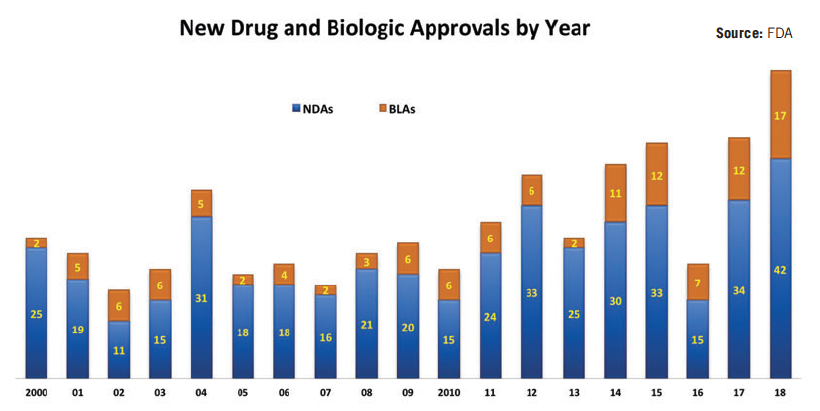
companies patented almost two-thirds of new drugs launched in 2018, and they accounted for 72% of the late-stage pipeline, compared with 65% in 2013 and 52% in 2003.
Overall, the late-stage pipeline grew by 11% in 2018, the IQVIA report says, and the total number of clinical trials started last year was up 9% over the prior year and 35% over the past five years. According to the Tufts Center for the Study of Drug Development (CSDD), half of all drugs in the R&D pipeline-and about 80% of all investigational drugs for cancer-related diseases-now rely on biomarker and genetic data to target therapeutic agents. Ken Getz, the director of sponsored research at Tufts CSDD, notes in a new column in Pharm Exec sister publication Applied Clinical Trials that there are now more than 11,000 active molecules in development-a 5% to 7% year-over-year growth rate across the span of two decades.
Addressing 2018’s record number of US approvals, Getz notes that 73% were approved under “priority review” status, and that one-third of the new approvals were first-in-class drugs offering new ways of treating certain diseases.
“This is a remarkable achievement, particularly in light of the anemic number of annual approvals that we saw in the 2005 to 2010 period,” Getz states.
But, of course, even amid the reveling over pharma’s innovation resurgence, drug development remains essentially a high-risk investment. A recent study by Accenture did find that treatments considered more innovative-tied in with things like genomics, biomarkers, companion diagnostics, and new delivery methods-are actually more likely to reach the market, slightly bucking the long-held belief that about nine out of 10 drugs that enter clinical testing fail (in analyzing 60,000 products from 2000 to 2017, Accenture reported a successful clinic-to-market range of 6% to 40%).
While pinpointing exact failure rates may not be an exact science, Getz, nevertheless, reminds us that drug development processes are highly complex and inefficient, and have done little to improve durations. He contends as well that, on average, the typical drug generates a relatively low and declining return on its development investment, given the high capitalized cost of bringing a drug through FDA approval. Getz says that about $150 billion was spent on global R&D activity in 2018.
“To remain viable, drug developers must transform long-standing R&D operating processes and practices that are largely insular and sequential, supported by redundant resources and personnel and that underutilize key assets and expertise,” he writes. “The growing prominence of precision medicines and treatments for rare diseases and targeted patient subpopulations-all requiring more complex clinical trial designs and longer durations to identify and recruit patients-intensify the pressure on drug developers to accelerate this transformation.”
Some in big pharma seem to be responding. Last month, Novartis, Otsuka, Pfizer, and Sanofi all formed alliances with Verily, Alphabet’s life sciences unit, in hopes of reshaping clinical trials in disease areas such as cancer, mental health, diabetes, dermatology, and heart disease. The pharmas will develop clinical research programs using technology developed under Verily’s Project Baseline. The Baseline platform is designed to engage larger numbers of patients and clinicians in research and collect more comprehensive, higher quality data. The partners will also explore novel approaches to generating real-world evidence (RWE) using the platform to organize and activate health information from electronic health records, sensors, and other digital sources.
Pharma’s interest in RWE has grown considerably. Both Pfizer and BMS, for example, recently struck strategic agreements with Concerto HealthAI, which focuses on cancer-specific real-world data (RWD) and advanced artificial intelligence (AI) for RWE generation. The companies will use Concerto’s platform and AI models to identify and develop precision oncology drugs, as well as better understand how medicines are used to help improve patient outcomes.
Overall, the industry has increased its adoption of AI and machine learning on numerous fronts. A recent analysis by Tufts CSDD and DIA found that the clinical operations function makes the highest use of AI, followed by pharmacovigilance/safety/risk management, and information technology. The promise of cloud technology is also building momentum in pharma R&D circles to help process the large volumes of data and multiple and disparate data sources now involved in clinical research.
Michael Christel is Pharm Exec’s Managing Editor. He can be reached at mchristel@mmhgroup.com
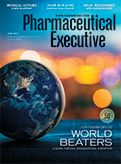
Cell and Gene Therapy Check-in 2024
January 18th 2024Fran Gregory, VP of Emerging Therapies, Cardinal Health discusses her career, how both CAR-T therapies and personalization have been gaining momentum and what kind of progress we expect to see from them, some of the biggest hurdles facing their section of the industry, the importance of patient advocacy and so much more.